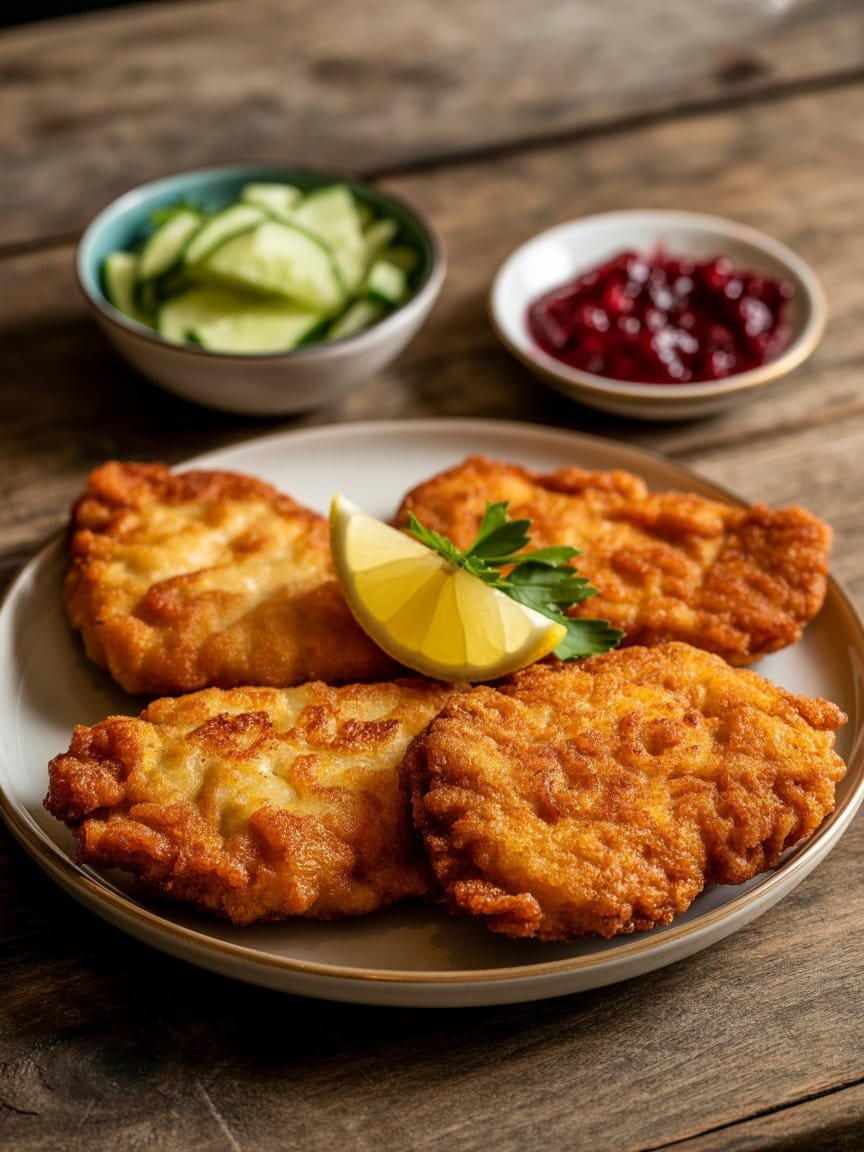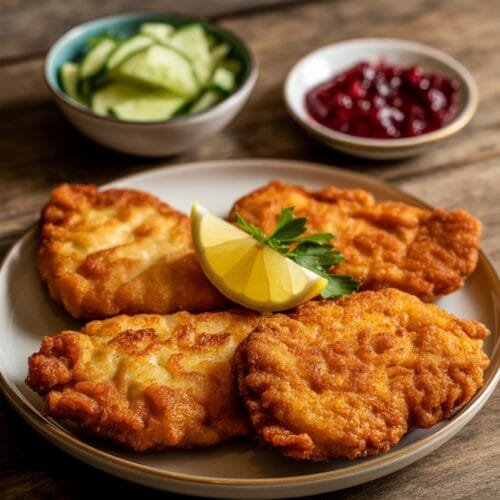Traditional Austrian Wiener Schnitzel Recipe

There’s something wonderfully nostalgic and satisfying about a perfectly golden, crispy Wiener Schnitzel—a dish that sings of Old-World charm, Alpine kitchens, and centuries of culinary pride. Whether you first tasted it in a cozy Viennese gasthaus or you’re discovering it for the first time, this Traditional Austrian Wiener Schnitzel Recipe will walk you through everything you need to know to recreate the authentic experience at home.
As a professional chef who’s worked with classic European fare for decades, I can say this without hesitation: mastering the Wiener Schnitzel is a rite of passage. It’s deceptively simple yet demands technique, care, and quality ingredients to achieve the signature crunch and buttery tenderness that sets it apart.
In this long-form recipe blog post, you’ll learn:
- The cultural and culinary history behind Wiener Schnitzel
- Step-by-step preparation instructions
- Expert chef tips and tricks
- Authentic ingredients and substitutions
- Serving suggestions and popular Austrian sides
- Variations to try once you’ve mastered the classic
Let’s take a culinary journey straight to the heart of Austria, one schnitzel at a time.
What Is Wiener Schnitzel?
Wiener Schnitzel, directly translated as “Viennese Cutlet,” is a thin, breaded, and fried veal cutlet that’s traditionally served with lemon wedges, parsley potatoes or cucumber salad. It’s one of Austria’s most iconic dishes and is so beloved that it’s protected by law—yes, really. Only schnitzel made with veal can be called Wiener Schnitzel in Austria. If it’s made with pork or chicken, it must be labeled accordingly (e.g., Schnitzel vom Schwein).
While variations of breaded cutlets exist around the world—from Italy’s Cotoletta alla Milanese to Japan’s Tonkatsu—what makes the Traditional Austrian Wiener Schnitzel Recipe unique is its ultra-light breading, tender meat, and the distinct Viennese touch that comes with centuries of refinement.
Ingredients for Traditional Wiener Schnitzel
To keep this Traditional Austrian Wiener Schnitzel Recipe as authentic as possible, you’ll want to gather the highest-quality ingredients available.
Essential Ingredients:
- 4 veal cutlets (around 5 oz / 140g each), pounded thin
- Salt and freshly ground white pepper, to taste
- All-purpose flour, for dredging
- 2 large eggs, lightly beaten
- Plain breadcrumbs (unseasoned, preferably homemade)
- Clarified butter (or a neutral oil like sunflower or grapeseed), for frying
- Lemon wedges, for serving
- Parsley sprigs, optional garnish
💡 Chef’s Note: For a truly classic result, veal is non-negotiable. However, pork, chicken, or turkey can be used in variations—just know it’s not a “true” Wiener Schnitzel if you stray from veal.
Kitchen Tools You’ll Need
- Meat mallet or rolling pin (for pounding the cutlets)
- Three shallow dishes for breading
- Large skillet (preferably stainless steel or cast iron)
- Tongs or a fish spatula (for turning the schnitzel gently)
- Paper towels (for draining)
Step-by-Step: How to Make Wiener Schnitzel Like an Austrian Chef
1. Prepare the Veal
Place each veal cutlet between two sheets of plastic wrap or parchment paper. Use a meat mallet to pound it evenly to 1/8 inch thickness. Don’t rush this step—uniform thickness ensures even cooking and that delicate “fluff” you want in the breading.
2. Season
Season both sides of the veal with salt and a light dusting of white pepper. Remember, simplicity is key here—Wiener Schnitzel is about the clean taste of the veal and the crisp coating.
3. Set Up the Breading Station
Arrange three shallow dishes:
- Dish 1: All-purpose flour
- Dish 2: Beaten eggs
- Dish 3: Plain breadcrumbs
Dredge each veal cutlet in the flour (shake off excess), dip in egg, then press into breadcrumbs. Do not press the breadcrumbs too hard—you want a light coating that will puff and crisp as it fries.
🧑🍳 Pro Tip: Use one hand for wet ingredients and one for dry to avoid the dreaded “breadcrumb glove.”
4. Heat the Fat
In a large skillet, heat clarified butter over medium-high heat. You’ll need enough to allow the schnitzel to “swim” slightly—this encourages the classic bubbling effect of the crust.
Heat the fat to around 330–350°F (165–175°C). Test with a breadcrumb—it should sizzle immediately.
5. Fry to Perfection
Gently lower the breaded veal into the hot butter. Fry for 1.5 to 2 minutes per side, turning once the underside is golden. You’ll know it’s right when the schnitzel puffs and ripples, with golden, flaky ridges forming across the surface.
⚠️ Never overcrowd the pan! Fry in batches if needed.
6. Drain and Rest
Transfer schnitzels to a paper towel-lined plate or wire rack. Allow to rest for a minute or two before serving—this helps preserve the crispy texture.
Serving Suggestions: How to Plate Like an Austrian Pro
In Austria, Wiener Schnitzel is traditionally served with:
- Petersilienkartoffeln (boiled potatoes with parsley and butter)
- Gurkensalat (cucumber salad with vinegar, sugar, and dill)
- Lingonberry or cranberry jam (adds a sweet-tart contrast)
- Lemon wedges, always
Keep it simple and let the schnitzel shine. A glass of crisp Grüner Veltliner or a cold Austrian lager makes for a perfect pairing.
Tips for a Perfect Wiener Schnitzel
Achieving the perfect Traditional Austrian Wiener Schnitzel is all about technique. Here are a few chef-tested tips:
✅ Use clarified butter:
It has a higher smoke point than regular butter and adds that unmistakably rich Austrian flavor.
✅ Pound evenly:
Uneven meat leads to uneven cooking—and potentially dry or rubbery spots.
✅ Don’t skip the “swimming”:
Allowing the schnitzel to float slightly in hot fat is what creates the signature puffed texture.
✅ Keep it moving:
Tilt and shake the pan gently while frying to encourage even bubbling and a curled edge.
✅ Serve immediately:
This dish waits for no one. Serve hot for the best crisp and flavor.
Variations: What If You Don’t Have Veal?
While veal is the gold standard, not everyone has access—or appetite—for it. Luckily, the technique works beautifully with other proteins:
- Pork Schnitzel (Schnitzel Wiener Art): More affordable and widely used in home kitchens
- Chicken Schnitzel: Kid-friendly and lean
- Turkey Schnitzel: Popular in Austria, especially around holidays
- Vegetarian Schnitzel: Try thin-sliced celery root, eggplant, or even firm tofu
Each variation follows the same breading and frying technique. Just remember to adjust cooking time according to the protein.
Storing & Reheating Leftovers
Wiener Schnitzel is best enjoyed fresh, but if you have leftovers:
To store:
Place in an airtight container with paper towels between layers. Refrigerate for up to 2 days.
To reheat:
Avoid the microwave. Instead, reheat in a hot oven (375°F/190°C) for 10–12 minutes on a wire rack until crispy again.
Austrian Culinary History: The Origins of Wiener Schnitzel
There’s been long-standing debate about the true origin of Wiener Schnitzel. One theory claims it was inspired by Italian Cotoletta alla Milanese, brought to Austria in the 19th century by Field Marshal Radetzky. Others insist the dish developed independently in Vienna.
Whatever its origin, the dish gained popularity rapidly and became embedded in Austrian culture—so much so that it’s now protected under Austrian law. The term “Wiener Schnitzel” is a Protected Designation of Origin (PDO) under Austrian food regulation.
Final Thoughts: Why This Traditional Austrian Wiener Schnitzel Recipe Belongs in Every Kitchen
The Traditional Austrian Wiener Schnitzel Recipe is more than just a meal—it’s a piece of culinary history served on a plate. Its simplicity is deceptive; its flavors are timeless. With just a few ingredients and proper technique, you can create a dish that feels both elegant and comforting.
Whether you’re serving it for a weekend dinner or showcasing your European cooking skills for a dinner party, Wiener Schnitzel is a guaranteed crowd-pleaser.
If you’ve never made it before, now’s the perfect time. And if you have? Well, it’s always worth returning to the classics.

Traditional Austrian Wiener Schnitzel Recipe
Ingredients
- 4 veal cutlets about 5 oz / 140g each, pounded thin
- Salt to taste
- White pepper to taste
- 1/2 cup all-purpose flour
- 2 large eggs lightly beaten
- 1 1/2 cups plain breadcrumbs preferably homemade
- 1 cup clarified butter or neutral oil e.g., sunflower or grapeseed
- Lemon wedges for serving
- Fresh parsley for garnish (optional)
Instructions
Step 1: Prepare the Cutlets
- Place each veal cutlet between two sheets of plastic wrap or parchment paper and pound evenly to 1/8-inch thickness.
Step 2: Season
- Season both sides of the cutlets with salt and a light dusting of white pepper.
Step 3: Bread the Cutlets
- Set up a breading station with three shallow dishes: flour, beaten eggs, and breadcrumbs. Dredge each cutlet in flour (shake off excess), then dip in egg, and finally coat in breadcrumbs. Do not press the breadcrumbs in; keep it light and fluffy.
Step 4: Heat the Fat
- In a large skillet, heat clarified butter or oil to 330–350°F (165–175°C). The cutlets should be able to “swim” lightly in the fat.
Step 5: Fry the Schnitzels
- Fry each breaded veal cutlet for 1.5–2 minutes per side until golden brown and crisp. Shake the pan gently while frying to help the coating puff.
Step 6: Drain and Serve
- Remove and place on a paper towel-lined plate or wire rack. Serve immediately with lemon wedges and parsley garnish.
Notes
- Clarified butter is traditional and imparts rich flavor, but sunflower or grapeseed oil works as well.
- For best results, avoid pressing the breadcrumbs onto the meat—this keeps the crust light and crisp.
- Storage: Store cooled schnitzels in an airtight container lined with paper towels. Refrigerate for up to 2 days.
- Reheating: Reheat in a 375°F (190°C) oven on a wire rack for 10–12 minutes. Avoid microwaving.
- Variations: Use pork or chicken if veal is unavailable (not authentic, but still delicious). Try celery root or eggplant for vegetarian options.
